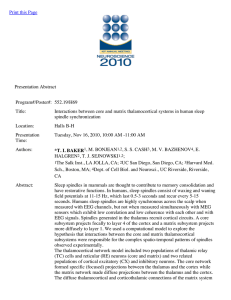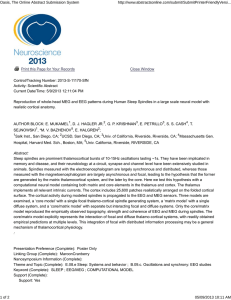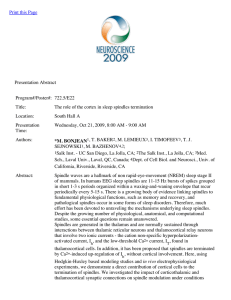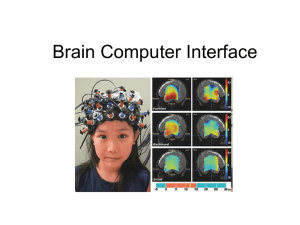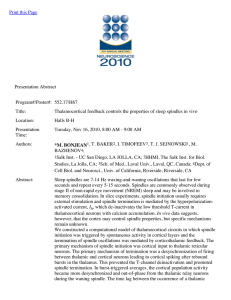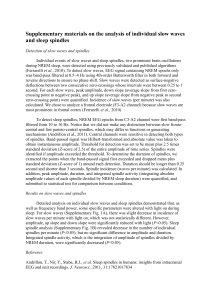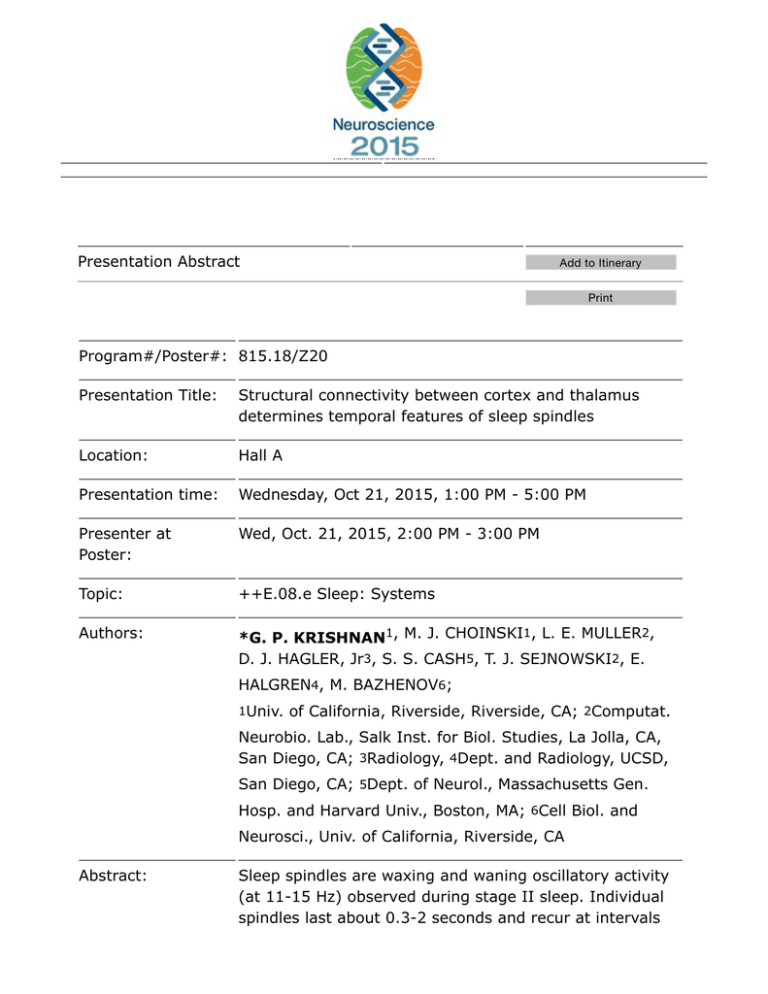
Presentation Abstract
Add to Itinerary
Print
Program#/Poster#: 815.18/Z20
Presentation Title:
Structural connectivity between cortex and thalamus
determines temporal features of sleep spindles
Location:
Hall A
Presentation time:
Wednesday, Oct 21, 2015, 1:00 PM - 5:00 PM
Presenter at
Poster:
Wed, Oct. 21, 2015, 2:00 PM - 3:00 PM
Topic:
++E.08.e Sleep: Systems
Authors:
*G. P. KRISHNAN1, M. J. CHOINSKI1, L. E. MULLER2,
D. J. HAGLER, Jr3, S. S. CASH5, T. J. SEJNOWSKI2, E.
HALGREN4, M. BAZHENOV6;
1Univ.
of California, Riverside, Riverside, CA; 2Computat.
Neurobio. Lab., Salk Inst. for Biol. Studies, La Jolla, CA,
San Diego, CA; 3Radiology, 4Dept. and Radiology, UCSD,
San Diego, CA; 5Dept. of Neurol., Massachusetts Gen.
Hosp. and Harvard Univ., Boston, MA; 6Cell Biol. and
Neurosci., Univ. of California, Riverside, CA
Abstract:
Sleep spindles are waxing and waning oscillatory activity
(at 11-15 Hz) observed during stage II sleep. Individual
spindles last about 0.3-2 seconds and recur at intervals
from 2 to 15 seconds. MEG and EEG show significant
differences in spindle occurrences, with about 50% of
MEG spindles occurring without EEG spindles whereas
only 15% of EEG spindles occur alone [1]. Spindles
generated in the thalamus recruit cortical circuits. A core
subsystem projects focally to layer 4 of the cortex and a
matrix subsystem projects more diffusely to apical
dendrites of layer 5 neurons in layer 1. We previously
hypothesized that difference between MEG and EEG
signals may reflect difference between those projections
[2]. In this study, we used computational modeling and
laminar recordings from epilepsy patients to identify the
mechanism that results in differences in spindle
occurrence across different cortical layers. Laminar
recordings showed higher probability of spindle
occurrence (based on automated spindle detection) in
middle layers (putative layers 3/4) compared to deeper
layers (putative layers 5/6). Using a reduced
thalamocortical model with only one cortical layer (with
pyramidal and inhibitory neurons) and a corresponding
thalamic network (thalamocortical and reticular neurons)
we found that the interspindle interval and the
probability of spindle occurrence in a given interval
decreased with increases in the level of spontaneous
miniature excitatory synaptic activity and increases in
the fanout (number of efferent neurons connected) of
thalamocortical and corticothalamic connectivity. We
then simulated a multilayer cortex model, which included
three layers for cortex (layer 3/4, 5 and 6) and separate
thalamic neurons for core and matrix subsystems. The
fanout of the thalmocortical and corticothalamic
projections between matrix thalamic neurons to layer 5
neurons was made to be wider than the core thalamic
neuron projections to layer 3/4. In the full model,
spindles occurred more often in layer 3/4 than in layer 5,
with a shorter median inter-spindle interval. In addition,
the spindles in layer 5 were more synchronous across
neurons compared to layer 3/4. Overall, this study
demonstrates that differences in the projections between
thalamus and cortex may determine the spatiotemporal
features of spindle activity across cortical layers.
References 1. Dehghani N, Cash SS, Halgren E (2011)
Emergence of synchronous EEG spindles from
asynchronous MEG spindles. Hum Brain Mapp 2. Bonjean
M, Baker T, Bazhenov M, Cash S, Halgren E, et al. (2012)
Interactions between Core and Matrix Thalamocortical
Projections in Human Sleep Spindle Synchronization. J of
Neuroscience
Disclosures:
G.P. Krishnan: None. M.J. Choinski: None. L.E.
Muller: None. D.J. Hagler: None. S.S. Cash: None. T.J.
Sejnowski: None. E. Halgren: None. M. Bazhenov:
None.
Keyword (s):
sleep spindles
computational model
core and matrix
Support:
MURI: N000141310672
NIH: R01 MH0996
NIH: R01 EB009282
Note: When adding items to your Itinerary, please click "Add Checked Selections to
My Itinerary" on EACH page of your search results.
At the Meeting
Sessions/Events
Abstracts
Registration
Hotel/Travel
Exhibits
Fellowships, Awards, and Prizes
Frequently Asked Questions
CME
Access the SFN Member Center
OASIS Technical Support.
Monday - Friday, 9 am - 5 pm CT
Phone: 1-217-398-1792
Email: OASIS Helpdesk
Leave OASIS Feedback
The Online
Abstract
Submission and
Invitation
System
© 1996 - 2015
Coe-Truman
Technologies,
Inc. All rights
reserved.

